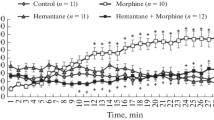Summary
Our previous studies indicate that repeated nicotine administration inhibits the release of striatal dopamine in hypothermic mice. To study if similar inhibition occurs in noradrenergic and serotoninergic neurons mice were given (−)-nicotine (3 mg/kg, s.c.) repeatedly at 110, 80, 50, and 20 min before sacrifice. The interactions of nicotine with reserpine were also investigated. Reserpine (5 mg/kg, i.p.) was administered after the second nicotine dose at 60 min before sacrifice. To prevent the effects of nicotine on autonomic ganglia all mice were given hexamethonium (10 mg/kg, i.p.). Experiments were carried out at 20–22°C at which ambient temperature nicotine induced deep hypothermia or at 32–34°C to prevent the drug-induced hypothermia. The changes in striatal metabolism of dopamine, noradrenaline and 5-hydroxytryptamine (5-HT) we
Nicotine had temperature dependent effects on the dopamine metabolism which indicates a block of dopaminergic neurons as suggested in our earlier studies. Reserpine per se increased the homovanillic acid (HVA) and 3,4-dihydroxyphenylacetic acid (DOPAC) contents and decreased the 3-methoxytyramine (3-MT) and dopamine contents at both ambient temperatures. In hypothermic but not in “normothermic”, nicotine-treated mice reserpine's effect on dopamine metabolism was almost totally vanished. Nicotine and reserpine per se increased the 3-methoxy-4-hydroxyphenylethylglycol (MOPEG) content and decreased the noradrenaline content at both ambient temperatures. In hypothermic but not in “normothermic” mice nicotine antagonized the reserpine-induced decrease of noradrenaline content. Nicotine tended to decrease the 5-hydroxy-indoleacetic acid (5-HIAA) content in hypothermic mice but increased it in “normothermic” ones. Reserpine decreased the 5-HT content and increased the 5-HIAA content at both ambient temperatures. In hypothermic but not in “normothermic”, nicotine-treated mice the reserpine-induced effects on 5-HT metabolism were clearly reduced. These results indicate that in hypothermic mice repeatedly administered nicotine blocks the release of striatal dopamine and 5-HT and perhaps also noradrenaline. The nicotine-induced antagonism of the effects of reserpine is temperature-dependent as the nicotine-induced blockade of the neurons and thus the main mechanism behind both of these phenomena could be the sustained depolarization of the monoaminergic neurons.
Similar content being viewed by others
References
Arqueros L, Naquira D, Zunino E (1978) Nicotine-induced release of catecholamines from rat hippocampus and striatum. Biochem Pharmacol 27:2667–2674
Bhagat B, Kramer SZ, Seifter J (1967) The effects of nicotine and other drugs on the release of injected 3H-norepinephrine and on endogenous norepinephrine levels in the rat brain. Eur J Pharmacol 2:234–235
Bigland B, Goetzee B, Maclagan J, Zaimis E (1958) The effect of lowered muscle temperature on the action of neuromuscular blocking drugs. J Physiol 141:425–434
Carlsson A (1966) Modification of sympathetic function. A pharmacological depletion of catecholamine stores. Pharmacol Rev 18:541–549
Haikala H (1986) Different changes in striatal dopamine metabolism induced by nicotine in mice kept at different ambient temperatures. Naunyn-Schmiedeberg's Arch Pharmacol 334: 373–376
Haikala H (1987) Use of a novel type of rotating disc electrode and a flow cell with laminar flow pattern for the electrochemical detection of biogenic monoamines and their metabolites after Sephadex gel chromatographic purification and high-performance liquid chromatographic isolation from rat brain. J Neurochem 49:1033–1041
Haikala H (1989) Dual effects of nicotine on neuroleptic-induced changes of striatal dopamine metabolism in mice. Pharmacol Toxicol (Copenhagen) 64: (in press)
Haikala H, Karmalahti T, Ahtee L (1986) The nicotine-induced changes in striatal dopamine metabolism of mice depend on body temperature. Brain Res 375:313–319
Malfors T (1965) Studies on adrenergic nerves. Acta Physiol Scand 64: Suppl 248
Paton WDM, Perry WLM (1953) The relationship between depolarization and block in cat's superior cervical ganglion. J Physiol (Lond) 119:43–57
Philippu A, Beyer J (1973) Dopamine and noradrenaline transport into subcellular vesicles of the striatum. Naunyn-Schmiedeberg's Arch Pharmacol 278:387–402
Philippu A, Matthaei H (1988) Transport and storage of catecholamines in vesicles. In: Trendelenburg U, Weiner N (eds) Catecholamines I. Springer, Berlin Heidelberg New York Tokyo, pp 1–27
Roffler-Tarlov S, Sharman DF, Tegerdine P (1971) 3,4-Dihydroxyphenylacetic acid and 4-hydroxy-3-methoxyphenylacetic acid in the mouse striatum: a reflection of intra- and extraneuronal metabolism of dopamine? Br J Pharmacol 42: 343–351
Saner A, Pletscher A (1978) Enhancement of 5-hydroxytryptamine synthesis in brain by monoamine depleting drugs. J Pharm Pharmacol 30:115–117
Tozer TN, Neff NH, Brodie BB (1966) Application of steady state kinetics to the synthesis rate and turnover time of serotonin in the brain of normal and reserpine-treated rats. J Pharm Exp Ther 153:177–182
Westerink BHC, Spaan SJ (1982) On the significance of endogenous 3-methoxytyramine for the effects of centrally acting drugs on dopamine release in the rat brain. J Neurochem 38:680–686
Author information
Authors and Affiliations
Additional information
Send offprint requests to H. Haikala at the above address
Rights and permissions
About this article
Cite this article
Haikala, H., Leikola-Pelho, T. Nicotine antagonizes the effects of reserpine on the striatal metabolism of dopamine, 5-hydroxytryptamine and noradrenaline in hypothermic but not in normothermic mice. Naunyn-Schmiedeberg's Arch Pharmacol 339, 546–550 (1989). https://doi.org/10.1007/BF00167259
Received:
Accepted:
Issue Date:
DOI: https://doi.org/10.1007/BF00167259




